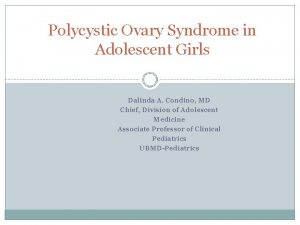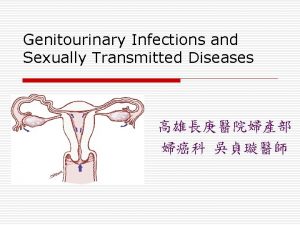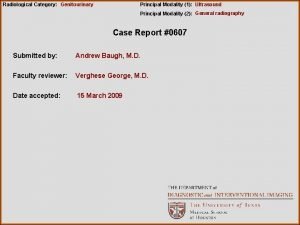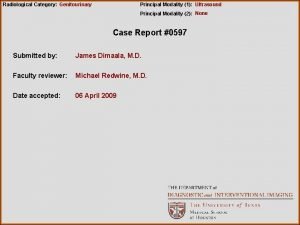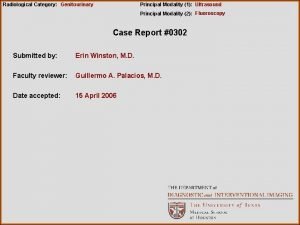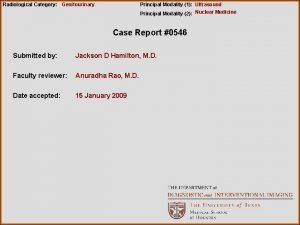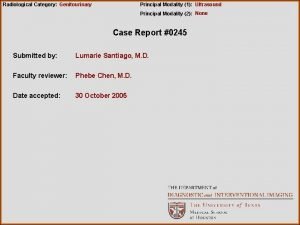Radiological Category Genitourinary Principal Modality 1 Ultrasound Principal










- Slides: 10

Radiological Category: Genitourinary Principal Modality (1): Ultrasound Principal Modality (2): CT Case Report #0062 Submitted by: Byron Mischen, M. D. Faculty reviewer: Chitra Chandrasekhar, M. D. Date accepted: 4 February 2004

Case History 57 year old female with pelvic pain and abnormal vaginal bleeding.

Radiological Presentations

Radiological Presentations

Radiological Presentations

Radiological Presentations

Test Your Diagnosis Which one of the following is your choice for the appropriate diagnosis? After your selection, go to next page. • Uterine leiomyoma with incidental primary lung cancer. • Uterine leiomyoma with incidental benign pulmonary nodule. • Uterine leimyosarcoma with pulmonary metastasis.

Findings and Differentials Findings: Diffusely enlarged, heterogeneous uterus on transvaginal ultrasound. No normal endometrial stripe can be identified. Single pulmonary nodule in right lower lobe on subsequent CT. Differentials: • Uterine leiomyoma with incidental primary lung cancer. • Uterine leiomyoma with incidental benign pulmonary nodule. • Uterine leimyosarcoma with pulmonary metastasis.

Discussion • Uterine leiomyoma with incidental primary lung cancer – Leiomyomata are the most common pelvic tumor in women, and are benign. On ultrasound, they are heterogeneous and often multiple. On CT, this 57 year old patient was found to have a pulmonary nodule in the right lower lobe. In this age group, primary lung cancer has to be excluded. • Uterine leiomyoma with incidental benign pulmonary nodule. While lung cancer has to be excluded, multiple benign processes such as granuloma, infection, hamartoma or round atelectasis could have a similar appearance. • Uterine leimyosarcoma with pulmonary metastasis. Leiomyosarcoma of the uterus is rare. It can arise de novo or in the setting of a leiomyoma. The conversion rate of leiomyoma to leiomyosarcoma is less than 1%. No imaging modality is successful in differentiating leiomyoma from leiomyosarcoma. Leiomyosarcoma is an aggressive tumor that frequently metastasizes to the lungs. References: • Brant, William and Helms, Clyde. Fundamentals of Diagnostic Radiology (2 Ed. ). Philadelphia: Lippincott, Williams & Wilkins, 1999. pp. 377 -383, 861 -862. • Rock, J. and Thompson, J. Te Linde’s Operative Gynecology (8 Ed. ). Philadelphia: nd th Lippencott, Williams & Wilkins, 1997. pp. 731 -749, 1546 -1548.

Diagnosis Uterine leimyosarcoma with pulmonary metastasis. Biopsy was performed on the pulmonary nodule, confirming the diagnosis of leiomyosarcoma. Subsequently a hysterectomy was performed.
 Ferriman–gallwey score
Ferriman–gallwey score Erate pa
Erate pa Tennessee division of radiological health
Tennessee division of radiological health Center for devices and radiological health
Center for devices and radiological health National radiological emergency preparedness conference
National radiological emergency preparedness conference Radiological dispersal device
Radiological dispersal device Male genitourinary anatomy
Male genitourinary anatomy Chapter 29 the child with a genitourinary condition
Chapter 29 the child with a genitourinary condition Nursing diagnosis for undescended testis
Nursing diagnosis for undescended testis Chapter 29 the child with a genitourinary condition
Chapter 29 the child with a genitourinary condition Genitourinary & stds
Genitourinary & stds
